The page is continued from The Two Treaties of Fort Laramie.
Below constitutes a rough draft version of this particular history section. The heavily-upgraded textbook version will be available soon.
“The Indian Appropriations Act”, March 3rd, 1871
In the late nineteenth century, “Indian policy” began to place a growing emphasis on erasing a distinctive American Indian identity. To weaken the authority of tribal leaders, Congress passed the Indian Appropriation Act, which ended the practice of treating tribes as independent, sovereign nations.[1]
Indian Appropriations Act 1871
U.S. Code Title 25: Indian Tribes
25 U.S.C. Section 71
Future Treaties with Indian Tribes
“Sec. 71. No Indian nation or tribe within the territory of the United States shall be acknowledged or recognized as an independent nation, tribe, or power with whom the United States may contract by treaty; but no obligation of any treaty lawfully made and ratified with any such Indian nation or tribe prior to March 3, 1871, shall be hereby invalidated or impaired.
Such treaties, & any Executive orders & Acts of Congress under which the rights of any Indian tribe to fish are secured, shall be construed to prohibit (in addition to any other prohibition) the imposition (a thing that is imposed) under any law of a State or political subdivision thereof (i.e. “County” or “City” government) of any tax on any income derived from the exercise of rights to fish secured by such treaty, Executive order, or Act of Congress if section 7873 of title 26 does not permit a like Federal tax to be imposed on such income.”[2]
The passing of The Indian Appropriations Act 1871 was not in allignment with:
Article VI of The U.S. Constitution:
“This Constitution, and the laws of the United States which shall be made in pursuance thereof; and all treaties made, or which shall be made, under the authority of the United States, shall be the supreme law of the land; and the judges in every state shall be bound thereby, anything in the Constitution or laws of any State to the contrary notwithstanding.“[3]
Rule 5.1. Constitutional Challenge to a Statute—Notice, Certification, & Intervention
(a) Notice by a Party. A party that files a pleading, written motion, or other paper drawing into question the constitutionality of a federal or state statute must promptly:
(1) file a notice of constitutional question stating the question and identifying the paper that raises it, if:
(A) a federal statute is questioned and the parties do not include the United States, one of its agencies, or one of its officers or employees in an official capacity; or
(B) a state statute is questioned and the parties do not include the state, one of its agencies, or one of its officers or employees in an official capacity; and
(2) serve the notice and paper on the Attorney General of the United States if a federal statute is questioned—or on the state attorney general if a state statute is questioned— either by certified or registered mail or by sending it to an electronic address designated by the attorney general for this purpose.
(b) Certification by the Court. The court must, under 28 U.S.C. §2403, certify to the appropriate attorney general that a statute has been questioned.
(c) Intervention; Final Decision on the Merits. Unless the court sets a later time, the attorney general may intervene within 60 days after the notice is filed or after the court certifies the challenge, whichever is earlier. Before the time to intervene expires, the court may reject the constitutional challenge, but may not enter a final judgment holding the statute unconstitutional.
(d) No Forfeiture. A party’s failure to file and serve the notice, or the court’s failure to certify, does not forfeit a constitutional claim or defense that is otherwise timely asserted.[4]
NOTE: In Rule 5.1 “statute” means any congressional enactment that would qualify as an “Act of Congress.[4]
1862, The Homestead Act
President Abraham Lincoln signed the Homestead Act to open what was considered “government-owned land” (which was actually Native American land) to small family farmers― homesteaders. The act gave “any person” who was the head of a family 160 acres to try his hand at farming for five years. The individual had to be at least 21 years old, & was required to build a house on the property.
People interested in homesteading first had to file their intentions at the nearest Land Office (equivalent to the Assessor-Recorder’s Office today). A brief check for previous ownership claims was made for the plot of land in question, usually described by its survey coordinates. The prospective homesteader paid a filing fee of $10 to claim the land temporarily, as well as a $2 commission to the land agent.
With application & receipt in hand, the homesteader then returned to the land to begin the process of building a home & farming the land, both requirements for “proving up” at the end of five years. When all requirements had been completed & the homesteader was ready to apply for the Deed, the homesteader found two neighbors or friends willing to vouch for the truth of his or her statements about the land’s improvements & sign the “proof” document.
After successful completion of this final form & payment of a $6 fee, the homesteader received the patent for the land, signed with the name of the current President of the United States.[6] If a homesteader quit or failed to make a go of farming, his or her land reverted back to the government & was offered to the public again.
The Act was Considered Radical at the Time:
First off, “Homestead” is a legal term, which, when used, prevents a person’s home from being foreclosed on them:
Definition of HOMESTEAD, Black’s Law Dictionary:
“The home place; the place where the home is. It is the home, the house and the adjoining land, where the head of the family dwells; the home farm. The fixed residence of the head of a family, with the land and buildings surrounding the main house. See Oliver v. Snowden, IS Fla. 825, 43 Am. Itep. 33S; In re Allen (Cal.) 16 Pac. 319; McKeough v. MeKeough, 69 Vt. 34, 37 Atl. 275; Iioitt v. Webb, 36 N. II. 158; Frazer v. Weld, 177 Mass. 513, 59 N. E. IIS; Lyou v. Hardin, 129 Ala. 643, 29 South.777; Xorris v. Kidd, 28 Ark. 493. Technically, however, and under the modern homestead laws, a homestead is an artificial estate in land, devised to protect the possession and enjoyment of the owner against the claims of his creditors, by withdrawing the property from execution and forced sale, so long as the land is occupied as a home. Buckingham v. Buckingham, 81Mich. S9, 45 X. W. 504; Campbell v. Moran, 71 Xeb. 615, 99 N. W. 499; lkeu v. Oleniclt, 42 Tex. 19S; Jones v. Britton, 102 N. C. 106. 9 S. E. 554, 4 L. It. A. 178; Thomas v. Fulford, 117 X. C. 667, 23 S. E. 635; Ellinger v. Thomas, 04 Kan. ISO, 07 Pac. 529; Galligherv. Smiley, 28 Xeb. 189, 44 N. W. 187, 20 Am. St. Rep. 319.”[7]
The Act did not define what it meant to be the “head of a family”― just the age restriction of twenty-one― making it very egalitarian; it allowed African Americans, persecuted & famine-struck immigrants, & women a chance to find freedom & success in the West.[8] Note: “Rad” (as in “radical”) tranlates root in Latin.[9]
Definition of Egalitarian:
“of, relating to, or believing in the principle that all people are equal & deserve equal rights & opportunities.”[10]
Southern and Northern Merchants Resisted Earlier Versions of The Homestead Act
Before the Civil War, similar acts had been proposed in 1852, 1854 and 1859, but were defeated by a powerful southern lobby that feared new territories populated by homesteaders would be allowed into the Union as “free states,” thereby giving more power to the abolitionist movement. In addition, many in the northern manufacturing industries feared the Homestead Act would draw large numbers of their labor force away & into farming. In 1860, President James Buchanan vetoed an earlier homestead bill, succumbing to pressure from southern slave-holding interests.
This Version, However, Had A Loophole That was Abused:
This version of The Act offered an alternative to farmers via enabling them to opt to buy their “160 acre settlements” after only 6 months at the reasonable rate of $1.25 an acre— this became abused by merchant speculators— as many became bought out. Much of the land became purchased by individuals acting as a “front” for land merchant speculators who sought access to the vast untapped mining, timber, & water resources of the West. Speculators would offer to pay individuals cash or a share of profits in return for submitting their Homestead Act claim. By 1900, settlers— legitimate or otherwise— had gobbled up 80 million acres of land through the Homestead Act, & very little of the space was kept for homesteading. The act was officially repealed by Congress in 1976.[11]
The Homestead Act Was Devastating To Native Americans
To make way for homesteaders, the federal government forced Native American tribes onto reservations. Lincoln’s believed Native Americans should forsake their traditional ways of life & instead take up farming. Tribes fought vehemently to protect their tribal lands from white settlement. Their effort reached its high-water mark on June 25, 1876 in the Battle of Little Bighorn, where a combined force of Sioux, Cheyenne, & Arapaho eradicated Col. George A. Custer’s Seventh U.S. Cavalry regiment. But their success proved short-lived, & they soon found themselves under the control of the federal government’s Bureau of Indian Affairs, & subject to a coordinated campaign to Americanize Indian children in white-run schools.
Rapid Extermination of The American Buffalo, (peak year 1873)
An estimated two million bison were killed this year on the southern plains. Germany had developed a process to tan bison hides into fine leather.
Homesteaders collected bones from carcasses left by hunters. Bison bones were used in refining sugar, and in making fertilizer and fine bone china. Bison bones brought from $2.50 to $15.00 a ton. Based on an average price of $8 per ton they brought 2.5 million dollars into Kansas alone between 1868 and 1881. Assuming that about 100 skeletons were required to make one ton of bones, this represented the remains of more than 31 million bison.[12]
Photos from Buffalo Extirmination Era:
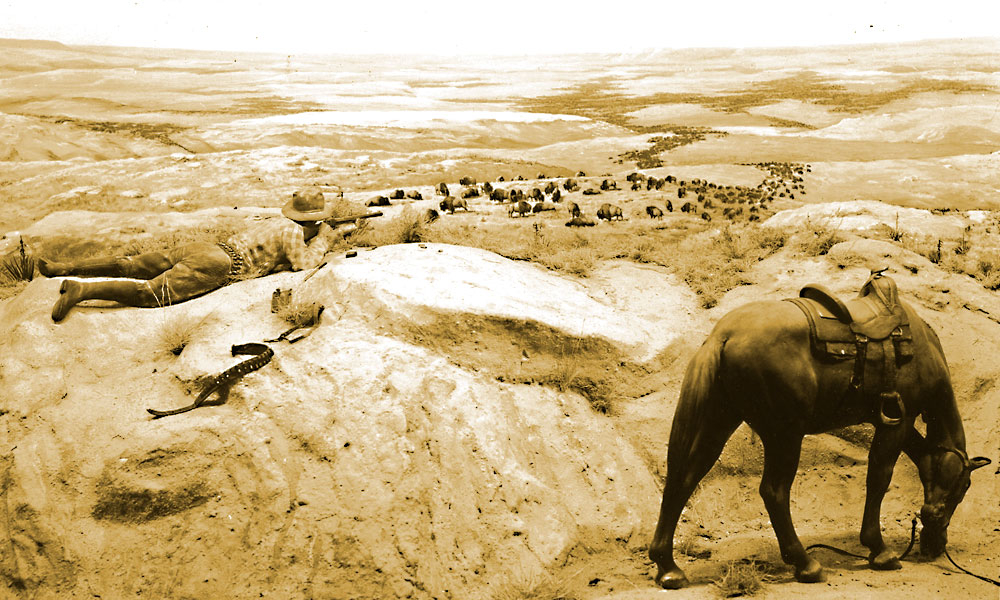
– Courtesy National Archives and Records Administration, Scotts Bluff National Monument –: http://www.truewestmagazine.com/the-buffalo-hunters-war/
Charles “Buffalo” Jones:
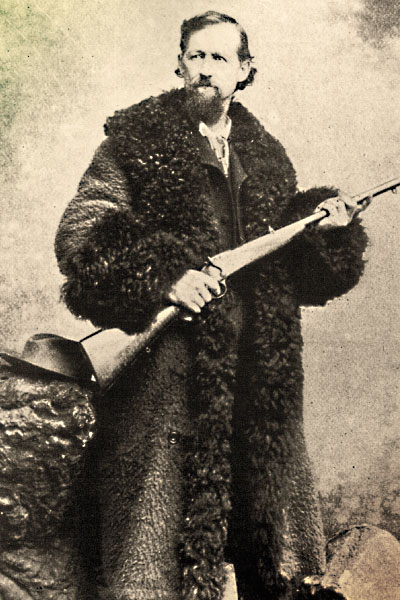
– True West Archives –: http://www.truewestmagazine.com/the-buffalo-hunters-war/
Men standing with enormous pile of buffalo skulls:
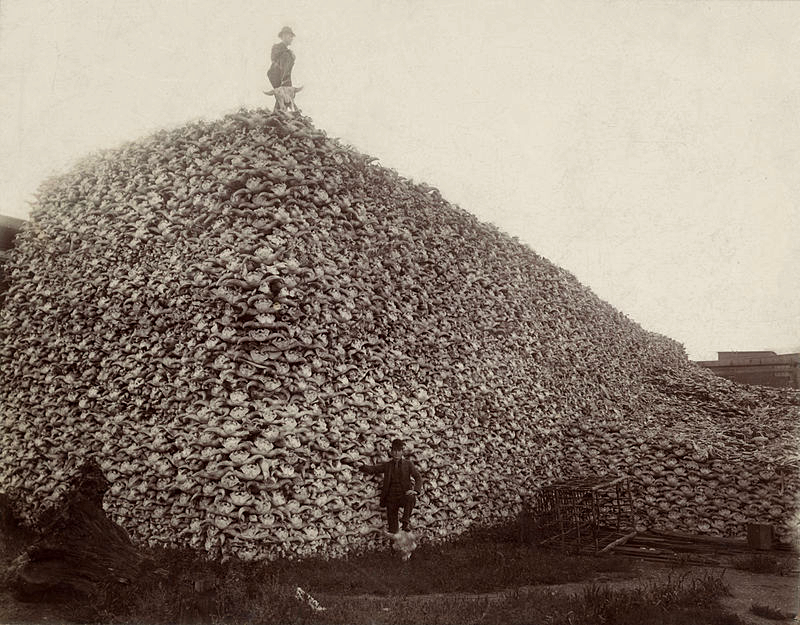
Note: Handwritten on back of the above photo: reads “C.D. 1892 Glueworks, office foot of 1st St., works at Rougeville, Mich.”
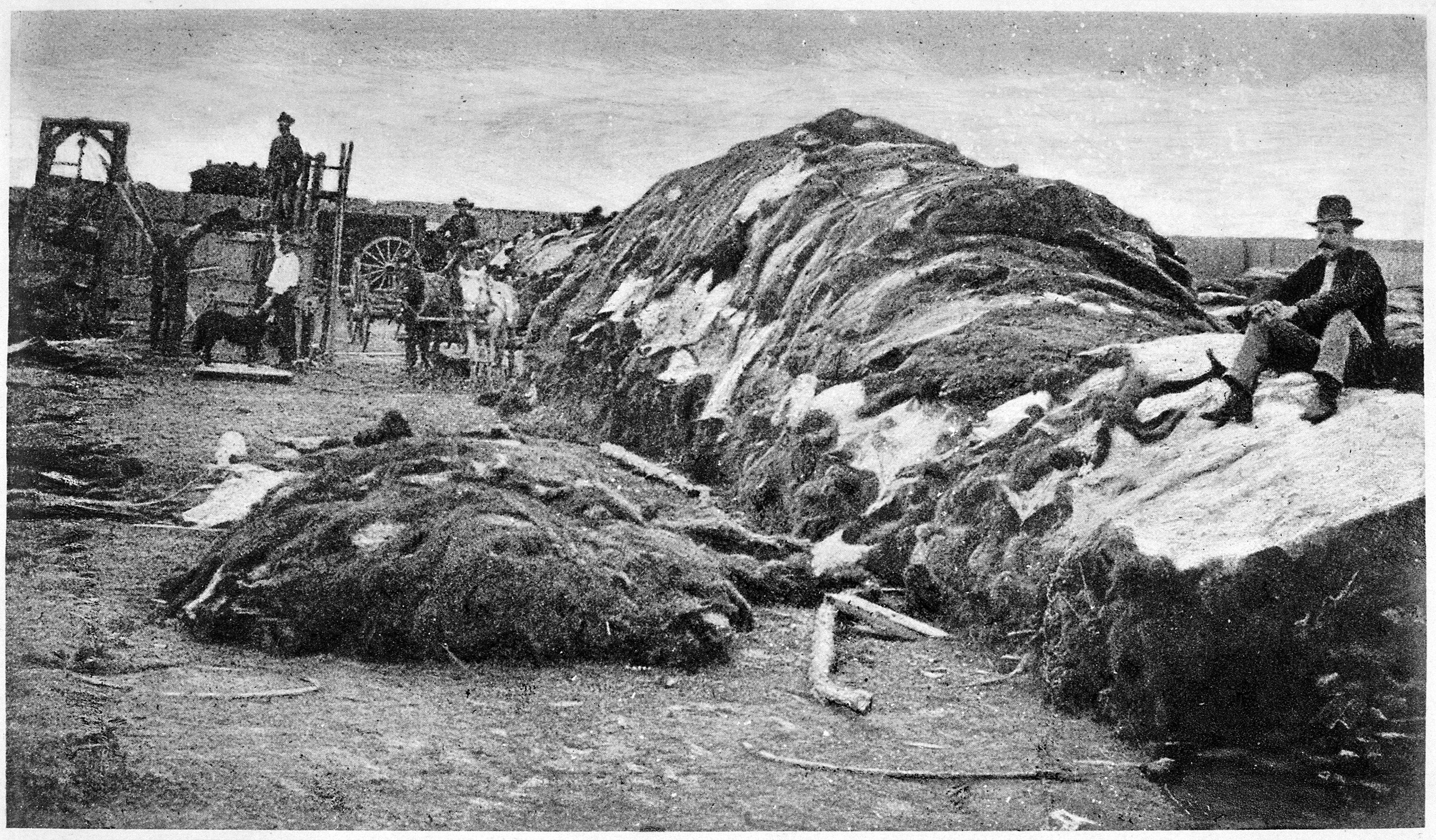
1876, Battle of Little Bighorn
The Battle of the Little Bighorn was fought along the ridges, steep bluffs, & ravines of the Little Bighorn River, in south central Montana on June 25-26, 1876. The combatants were warriors of the Lakota, Northern Cheyenne, & Arapaho tribes, battling men of the 7th Regiment of the U.S. Cavalry under the command of General Custer. The Battle of the Little Bighorn has come to symbolize the clash of two vastly dissimilar cultures: the buffalo/horse culture of the northern plains tribes, & the highly industrial/agricultural based culture of the U.S., which was advancing primarily from the east coast.
Although many Lakota leaders agreed to The Treaty of Fort Laramie, which created a large reservation in the western half of present day South Dakota, agreeing to the treaty meant accepting a more stationary life, & relying on government supplied subsidies. Lakota leaders such as Sitting Bull & Crazy Horse rejected the reservation system. Likewise many roving bands of hunters & warriors did not sign the 1868 treaty, & consequently, felt no obligation to conform to its restrictions, or to limit their hunting to the unceded hunting land assigned by the treaty.
Tension between the U.S. & the Lakota escalated in 1874, when Lt. Col. George Armstrong Custer was ordered to make an exploration of the Black Hills inside the boundary of the Great Sioux Reservation. Custer was to map the area, locate a suitable site for a future military post, & to make note of the natural resources. During the expedition, professional geologists discovered deposits of gold. Word of the discovery of mineral wealth caused an invasion of miners & entrepreneurs to the Black Hills in direct violation of the treaty of 1868. The U.S. negotiated with the Lakota to purchase the Black Hills, but the offered price was rejected. General George A. Custer led an expedition into the Black Hills accompanied by gold-seeking miners. Once gold was found, miners were soon moving into the native peoples’ hunting grounds & demanding protection from the U.S. Army. By 1875 the announcement led to the establishment of large mining towns, such as Deadwood, Central City, & Lead. Soon, the Army was ordered to move against wandering bands of Sioux hunting & foraging on the range in accordance with their treaty rights. The climax came in the winter of 1875, when the Commissioner of Indian Affairs issued an ultimatum requiring all “Sioux” to report to a reservation by January 31, 1876. The deadline came with virtually no response from the Indians, & matters were then handed to the military.
General Philip Sheridan, commander of the Military Division of the Missouri, devised a strategy that committed several thousand troops to find & to engage the Lakota & Cheyenne, who now were considered “hostile”, with the goal of forcing their return to the Great Sioux Reservation. The campaign was set in motion in March, 1876, when the Montana column, a 450 man force of combined cavalry & infantry commanded by Colonel John Gibbon, marched out of Fort Ellis near Bozeman Montana. A second force, numbering about 1,000 cavalry & infantry & commanded by General George Crook, was launched during the last week of May, from Fort Fetterman in central Wyoming. In the middle of May, a third force, under the command of General Alfred Terry, marched from Fort Abraham Lincoln, Bismarck, Dakota Territory, with a command comprised of 879 men. The bulk of this force was the 7th Cavalry, commanded by Lt. Col. George Armstrong Custer.
It was expected that any one of these three forces would be able to deal with the 800-1,500 warriors they likely were to encounter.
The well watered region of the Powder, Rosebud, Bighorn, & Yellowstone rivers were a productive hunting ground which tribes had been hunting at for hundreds of years, & the tribes regularly gathered in large numbers during the spring to celebrate their annual sun dance ceremony. The sun dance ceremony had occurred about two weeks earlier near present day Lame Deer, Montana. During the ceremony, Sitting Bull received a vision of soldiers falling upside down into his village. He prophesized there soon would be a great victory for his people.
On June 22, General Terry decided to detach Custer & his 7th Cavalry to make a wide flanking march & approach the natives from the east & south. Custer was to prevent the Lakota & their Cheyenne allies from slipping away & scattering. General Terry’s cavalry would approach from the north in order to surround them. The Indians, who were thought to be camped somewhere along the Little Bighorn River, “would be so completely enclosed as to make their escape virtually impossible”. These anti-Constitutional actions by U.S. Military were none other than an act of genocide.
Accompanied by Crow & Arikara scouts who had alerted him to the Lakota & Cheyennes’ location, Custer planned to launch an attack at dawn on June 26; however, the scouts reported the regiment’s presence had been detected by Lakota or Cheyenne warriors. Custer, judging the element of surprise to have been lost, feared the inhabitants would attack or scatter into the rugged landscape, causing the failure of the Army’s campaign. Custer ordered an immediate advance to engage the village & its warrior force.
Custer ordered the military units to “pitch into anything”. When it was reported that the village was scattering, Custer ordered Reno to lead his 140 man battalion, plus the Arikara scouts, & to “pitch into what was ahead” with the assurance that he would “be supported by the whole outfit”.
The Lakota & Cheyenne village lay in the broad river valley bottom, just west of the Little Bighorn River. As instructed by his commanding officer, Reno crossed the river about two miles south of the village & began advancing downstream toward its southern end. Though initially surprised, the warriors quickly rushed to fend off Reno’s assault. Reno halted his command, dismounted his troops & formed them into a skirmish line which began firing at the warriors who were advancing from the village. Mounted warriors pressed their attack against Reno’s skirmish line & soon endangered his left flank. Reno withdrew to a stand of timber beside the river, which offered better protection. Eventually, Reno ordered a second retreat, this time to the bluffs east of the river. The Sioux & Cheyenne, likening the pursuit of retreating troops to a buffalo hunt, rode down the troopers.
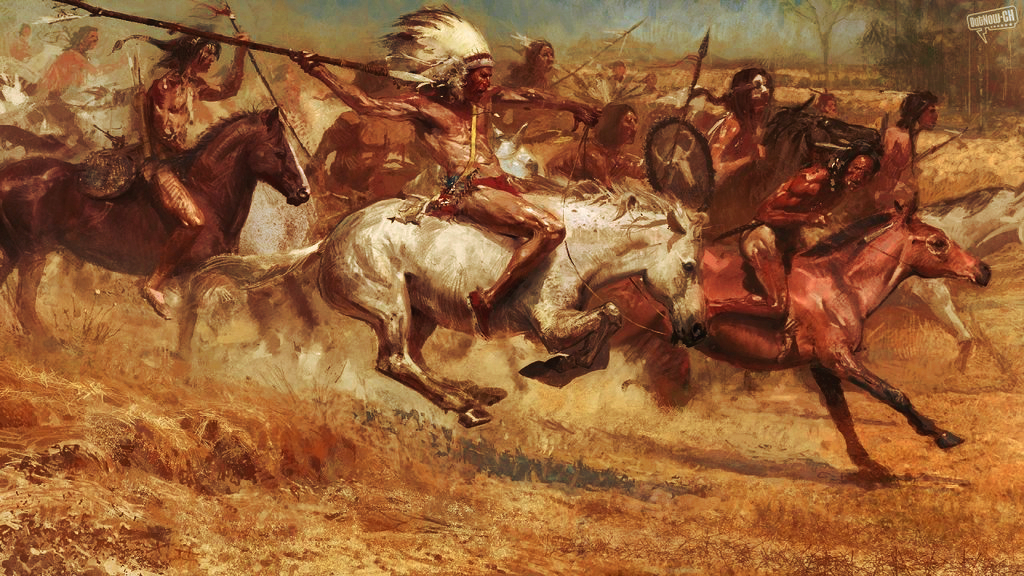
Soldiers at the rear of Reno’s fleeing command incurred heavy casualties as warriors galloped alongside the fleeing troops & shot them at close range, or pulled them out of their saddles onto the ground.
Large numbers of warriors approaching from that direction forced the cavalry to withdraw to Reno Hill where the natives held them under siege from the afternoon of June 25, until dusk on June 26. On the evening of June 26, the entire village began to move to the south.
Scouting parties, discovered the dead, naked, & mutilated bodies of Custer’s command on the ridges east of the river. Exactly what happened to Custer’s command never will be fully known. Superior numbers & overwhelming firepower brought the Custer portion of the Battle of the Little Bighorn to a close. The battle was a momentary victory for the Sioux & Cheyenne.
The So-Called “Great Sioux War” of 1876-77
General Phil Sheridan now had the leverage to put more troops in the field. Lakota Sioux hunting grounds were invaded by powerful Army expeditionary forces, determined to pacify the Northern Plains & unconstitutionally confine the Lakota & Cheyenne to reservations. A series of battles between the Lakota & allied tribes such as the Cheyenne against the United States military ensued, including the Battle of Powder River, Battle of the Rosebud, Battle of the Little Bighorn, Battle of Warbonnet Creek, Battle of Slim Buttes, Battle of Cedar Creek, & the Dull Knife Fight, & the final battle of Wolf Mountain. The series of battles occurred in Montana territory, Dakota territory, & Wyoming territory, & resulted in most of the declared “hostiles” to have surrendered within one year of the fight, & the Black Hills were then taken by the U.S. without compensation.[13]
1877, “The Sell or Starve Act”
After the defeat at the Battle of the Little Bighorn, Congress responded by attaching what Native Americans who were affected by it referred to as “the sell or starve” rider (19 Stat. 192) to the Indian Appropriations Act of 1876 (19 Stat. 176, enacted August 15, 1876), which cut off all rations for the “Sioux” until they terminated hostilities & ceded the Black Hills to the United States.[14]
The Agreement of 1877 (under the 19th President Rutherford B. Hayes), also known as the Act of February 28, 1877 (19 Stat. 254), is considered the most controversial treaty regarding the Black Hills land claims. The treaty officially took away Sioux land, & permanently established Indian reservations. Article 1 of the act modifies the boundaries of reservations stated in the 1868 Fort Laramie Treaty, while Article 2 allows the United States government to establish roads for settlers to travel upon when crossing the territory[15]:
Transcript of “The Sell or Starve Act”:
“For this amount, for subsistence, including the Yankton Sioux & Poncas, & for purposes of their civilization, one million dollars: Provided, “That none of said sums appropriated for said Sioux Indians shall be paid to any band thereof while said band is engaged in hostilities against the white people; & hereafter there shall be no appropriation made for the subsistence of said Indians, unless they shall first agree to relinquish all right & claim to any country outside the boundaries of the permanent reservation established by the treaty of eighteen hundred & sixty-eight for said Indians; & also so much of their said permanent reservation as lies west of the one hundred & third meridian of longitude, & shall also grant right of way over said reservation to the country thus ceded for wagon or other roads, from convenient & accessible points on the Missouri River […] the further sum of twenty thousand dollars is hereby appropriated to be expended under the direction of the President of the United States for the purpose of carrying into effect the foregoing provision: And provided also, that no further appropriation for said Sioux Indians for subsistence shall hereafter be made until some stipulation, agreement, or arrangement shall have been entered into by said Indians with the President of the United States, which is calculated and designed to enable said Indians to become self-supporting: Provided further, That the Secretary of the Interior may use of the foregoing amounts the sum of twenty-five thousand dollars for the removal of the Poncas to the Indian Territory, and providing them a home therein,a with the consent of said band.
That the balance of the fund of the Eastern band of Cherokee Indians, appropriated by the act of March third, eighteen hundred and seventy-five, shall, upon the first day of July, eighteen hundred and seventy-six, be placed to their credit upon the books of the Treasury Department, and shall bear interest at the rate of five per centum per annum; and the Secretary of the Interior is hereby authorized to use annually for agricultural implements and for educational purposes among said Indians so much of the principal of said fund as, with the interest annually accruing thereon, shall amount to six thousand dollars.
Approved, August 15, 1876.“[16]
Second Violation, 1887
The second violation of the Fort Laramie Treaty occurred when the Dawes Act (also called the General Allotment Act) was passed in February 8, 1887, written by Henry Dawes, the senator of Massachusetts. [17] [18]
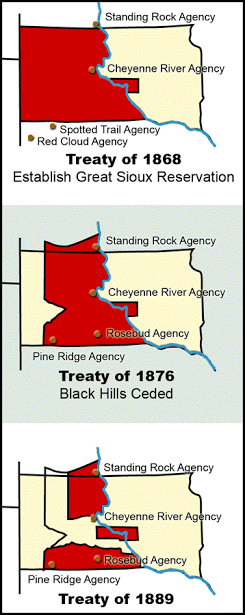
The Dawes act was “an Act to provide for the allotment of lands in severalty to Indians on the various reservations, and to extend the protection of the laws of the United States and the Territories over the Indians, and for other purposes.” [19]
The US Government used the Dawes Act to break up land that was commonly held by Lakotah/Dakotah/Nakota tribal members into small sections that were given out in fractions to individuals, but only individuals who had registered to a tribal “roll”.
The act stated that, “the President of the United States be, and he hereby is, authorized, whenever in his opinion any reservation or any part thereof of such Indians is advantageous for agricultural and grazing purposes, to cause said reservation, or any part thereof, to be surveyed, or resurveyed if necessary, and to allot the lands in said reservation in severalty to any Indian located thereon…”
Meaning, this act took away previous rights of the Lakotah/Dakotah/Nakota People that were originally given by the US Government with the 1851 Fort Laramie Treaty, as stated in Article 12: “No treaty for the cession of any portion or part of the reservation herein described which may be held in common shall be of any validity or force as against the said Indians, unless executed and signed by at least three-fourths of all the adult male Indians, occupying or interested in the same”, by giving the president the right to take land from the Natives as he saw fit. [20]
The Dawes Act was an illegal act, and the land claimed from it by the US Government is illegally-claimed. Illegally-claimed land is not equal to rightful ownership.
The Massacre at Wounded Knee, 1890
On December 29, 1890, at least 300 Lakota people – mostly women and children – were massacred at Wounded Knee Creek by the US Government. [21]
Daniel F. Royer, was sent as agent to the Pine Ridge Reservation in October of 1890. Agents were meant to ensure Native people received the land portions and provisions they were promised. Unfortunately Daniel Royer knew nothing of Native culture, was irrationally fearful of the Oglala Lakotas, and sent many warnings back to Washington, as if he were afraid the Lakota Peoples were planning to attack and kill him.
A year before he arrived, a Paiute named Wovoka created the Ghost Dance after his visions and meditations that told him to follow a path of spirituality. The Ghost Dance is a dance that blended Christianity with Native traditions, in hopes that doing it would return the bison, the Europeans would vanish, and the living and dead would be reunited in paradise. Royer’s paranoia led him to believe that the Ghost Dance was a “war dance”, warning of imminent doom for him.
Local residents of South Dakota demanded the Lakota Peoples stop Ghost Dancing, out of fear. When they refused, they called the government in for back up.
In mid-November 1890, President Benjamin Harrison sent two trains full of troops and newspaper reporters to the Pine Ridge Reservation from Nebraska and Omaha. When the troops and reporters arrived, they saw that there was in fact no crisis, but they continued to spread rumors and lies about a “Pine Ridge Crisis” all over the country. Mass hysteria broke out in regards to a “possible war” breaking out.
By mid-December, everyone in the region was utterly on edge due to the lies in the media, government reports, and the soldiers’ fear of the Ghost Dancing. The Lakota bands separated themselves into two camps – “hostiles”, those who were opposed to reservation life, and “friendlies”, those who preached a return to traditional ways. Ghost Dancers were typically assigned to the “hostile” camp. Tensions continued to rise.
Sitting Bull (Tantanka Iyotanka)
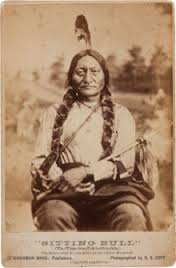
Sitting Bull, the Hunkpapa holy man and Ghost Dance leader, was highly recognized as an important military and political leader by many Lakota bands – some called him a “supreme chief”, firm in protecting the lands and traditional Lakota way. Sitting Bull led many groups to fight against the US government’s attempt to steal gold from the Black Hills. After decades of battles, he and his followers resorted to Ghost Dancing as spiritual respite, in response to the visions that both he and Wovoka both had. Sitting Bull knew he was coming close to the end of his life, and knew that the traditional native way of living would soon be gone, and stated, “I am the last Indian.” He was ordered to be arrested for Ghost Dancing, and was killed on December 15, 1890. [22]
The Massacre
The southern Lakota People – the Miniconjous – grew very nervous, as their leader, Big Foot, was also a Ghost Dancer. They fled to the Badlands in the south on December 23rd but were intercepted by the Seventh Calvary on December 28th, and were ordered into confinement on Wounded Knee Creek.
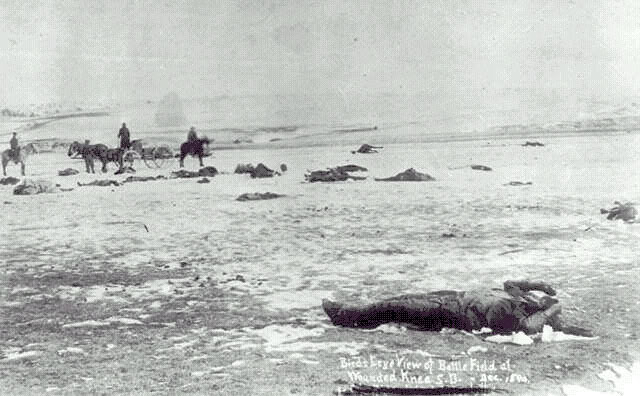
On December 29, Col. James W. Forsyth demanded the Minicononjous hand over their guns. The command was lost in translation, and the Lakotas believed they had been sentenced to exile, which incited a passionate Ghost Dance. The troops were terrified.
There are conflicting accounts of how the massacre started.
According to the Encyclopedia of the Great Plains, a Lakota man named Black Coyote (sometimes called Black Fox) would not give up his gun and during a struggle with a soldier who was attempting to take it, it discharged.
According to US History, amid the tension, a shot rang out, possibly from a deaf brave who misunderstood his chief’s orders to surrender. [23]
According to a Lakota woman we met here at Standing Rock (the very day we began to work on the Wounded Knee section, coincidentally enough), whose grandfather was shot and killed at Wounded Knee, both stories are correct. Black Coyote was deaf, and also refused to give up his gun, because he did not understand what was happening. During the struggle, his gun discharged.
Whichever the story, after the shot rang out, the soldiers began firing at the Lakota, who fled, as they were outnumbered and outgunned.
Many women and children standing by their tipis under a white flag of truce were cut down by deadly shrapnel from the Hotchkiss guns. The rest fled under withering fire from all sides. Pursuing soldiers shot most of them down in flight, some with babes on their backs. One survivor recalled that she was wounded but was so scared she did not feet it. She lost her husband, her little girl, and a baby boy. One shot passed through the baby’s body before it broke her elbow, causing her to drop his body. Two more shots ripped through the muscles of her back before she fell.
The fear of a reprisal attack kept troops and civilians entrenched at the agency until January 3, 1891 (some sources say it was until New Year’s Day). A pit was dug on the hill that the , and the frozen bodies of 146 men, women, and children were thrown into the pit until it was full. The whites stripped many of the bodies, keeping as souvenirs the Ghost Shirts and other clothing and equipment the people had owned in life, or selling them later in the thriving trade over Ghost Dance relics that ensued. One member of the burial party remarked that it was “a thing to melt the heart of a man, if it was of stone, to see those little children, with their bodies shot to pieces, thrown naked into the pit.” Besides the 146 buried that day, others who had been wounded died soon afterward, and relatives removed many of the bodies before the government burial party arrived. Estimates of the number of Lakotas slain vary, but many authorities believe that the figure is around three hundred men, women, and children. Not many escaped. [24]
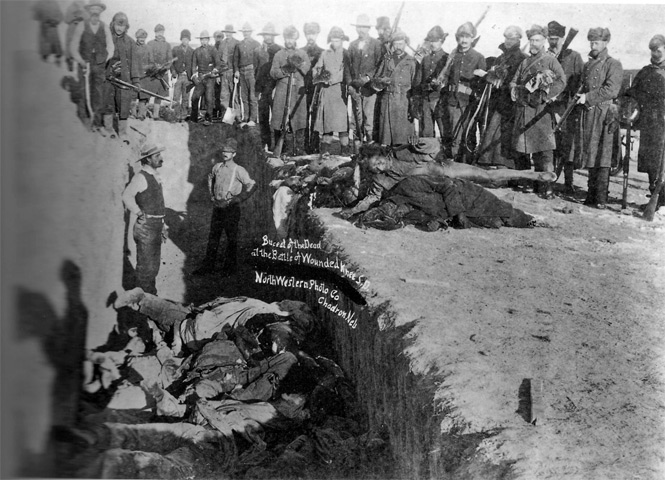
The Seventh Cavalry lost twenty-five men.
This massacre marked the last showdown between Native Americans and the United States Army. It was nearly 400 years after Christopher Columbus first contacted the first Americans. The 1890 United States census declared the frontier officially closed. The Lakota people lost a huge part of their community, including their greatest war chief and a lot of their traditional way of living.
Committee on Indian Depredations, 1893
The Committee on Indian Depredations was created in 1893 to replace a smaller committee that had been established to deal with an increased volume of Indian depredation claims. The original committee was created in 1889, interestingly being the year before the Massacre at Wounded Knee occurred, when rumors and lies about the Lakota were being spread in the media to cause mass hysteria.
The committee was closed in 1921. [25]
The Select Committee on the Extinguishment of Indian Title to Certain Lands existed for two weeks in 1818, which was replaced by the Committee on Indian Affairs in 1820. There were numerous committees created to control Natives and their land, but only the Select Committee on Indian Depredations, 1889-1893, left unprinted records. [26]
We can find biographical information on members, but there are no public records of any bills or case files that this so-called committee passed., only so-called “reports” of these “depredations” committed by Natives against white people, which there is no proof According to Chapter 20, Section 29 of the General Records of the US Senate, 1789-1968, “After the 56th Congress, the supporting papers are replaced by a similar series known as papers accompanying specific bills and resolutions, 1901-46 (1,048 ft.), often called legislative case files or bill files. This series is arranged numerically by bill or resolution number (S. 1, S. 2, and so forth) for each Congress from the 57th through the 79th (1901-46). The series includes files for House bills and joint resolutions if they passed the House and were then referred to Senate committees. Unlike the supporting papers, these records relate to both public and private bills. They were created and maintained by the committees to which the bills were referred, but were collected at the end of each Congress by the Secretary of the Senate and filed as a single series; it is therefore difficult to determine how many records are present in any Congress for any specific committee.”
We have contacted the FOIA (The Freedom of Information Act ; 5 U.S.C.552 ) to release the documents, in hopes that they will respond with the following message, which you can also do here (https://www.doi.gov/node/11498/done?sid=125124):
“Hello,
I would like to request a compiled list of any case files, bills, commission papers, petitions, memorials, and any other related documents passed by the Committee of Indian Depredations.
I need this information as soon as possible.
Thank you,
A concerned citizen”
This section will be updated once we obtain this info.
The Indian Reorganization Act, 1934
The Indian Reorganization Act was the centerpiece of the New Deal, a series of programs passed by Franklin D. Roosevelt that included the Social Security program and the Tennessee Valley Authority. It was designed as an attempt to restore rights to Native American Tribes in regards to land, water, and their unique ways of self-governing. It is described as “An Act To conserve and develop Indian lands and resources; to extend to Indians the right to form business and other organizations; to establish a credit system for Indians; to grant certain rights of home rule to Indians; to provide for vocational education for Indians; and for other purposes“. To this day, this act is used as the basis of any legislature in regards to Native Americans. Unfortunately, this act did not and does not accomplish what it seemingly appears it is meant to do. It continues to strip Native American Peoples of their rights by continuing to govern over their lands and cultural ways of living. [27] [28]
The act states, “Nothing herein contained shall restrict the granting or use of permits for easements or rights-of-way; or ingress or, egress over the lands for all proper and lawful purposes …” giving the government permission to pass their unlawful permits and easements that steal land and waterways from Native communities, as we are witnessing today.
The act also grants the government permission to regulate Native lands and how they produce agriculture: “The Secretary of the Interior is directed to make rules and regulations for the operation and management of Indian forestry units on the principle of sustained-yield management, to restrict the number of livestock grazed on Indian range units to the estimated carrying capacity of such ranges, and to promulgate such other rules and regulations as may be necessary to protect the range from deterioration, to prevent soil erosion, to assure full utilization of the range, and like purposes.” Native Peoples possess the knowledge of living in the wild that is necessary to survive, and do not need any regulations to deem how they should be doing it.
“Any Indian tribe, or tribes, residing on the same reservation, shall have the right to organize for its common welfare, and may adopt an appropriate constitution and bylaws, which shall become effective when ratified by a majority vote of the adult members of the tribe, or of the adult Indians residing on such reservation, as the case may be, at a special election authorized and called by the Secretary of the Interior under such rules and regulations as he may prescribe. Such constitution and bylaws when ratified as aforesaid and approved by the Secretary of the Interior shall be revocable by an election open to the same voters and conducted in the same manner as hereinabove provided. Amendments to the constitution and bylaws may be ratified and approved by the Secretary in the same manner as the original constitution and bylaws.” The act wrongfully holds “tribe” and “reservation” as equivalent wording, which caused an outbreak of division among and amidst various tribes shortly after the passing of this act. The tribes began to write tribal constitutions some of which upheld their traditions, but some of which upheld the Admiralty Law of the American Government, causing unrest among the people. [29]
The act also contains confusing language, such as the following: “This Act shall not apply to any reservation wherein a majority of the adult Indians, voting at a special election duly called by the Secretary of the Interior, shall vote against its application. It shall be the duty of the Secretary of the Interior, within one year after the passage and approval of this Act, to call such an election, which election shall be held by secret ballot upon thirty days’ notice.” This is a blatant misuse of power by the government, and an attempt to keep important legal matters hidden from being common knowledge.
Although the Indian Reorganization Act is described as being beneficial to the Native American Tribes, it can be easily interpreted as nothing but a ratification of the already unjust laws passed that stole Tribal lands and waterways, once read in between the lines. It is the basis of laws and regulations regarding Native Peoples that are passed today, proving that the US Government still breaks many of their original treaties with the Native People, including the Fort Laramie Treaty of 1851.
This page is in-the-making.

[1]: The Gilder Lehrman Institute of American History, Indian Appropriations Act: https://www.gilderlehrman.org/history-by-era/reconstruction/timeline-terms/indian-appropriation-act
[2]: UL-Lafayette, Indian Appropriations Act: http://www.ucs.louisiana.edu/~ras2777/indianlaw/appropriations.htm
[3]: Transcript of The Constitution of The United States: https://www.google.com/webhp?sourceid=chrome-instant&ion=1&espv=2&ie=UTF-8#q=transcript%20fo%20the%20constitution%20of%20the%20united%20states
[4]: 28 U.S.C. , United States Code, 2011 Edition, Title 28 – JUDICIARY AND JUDICIAL PROCEDURE
TITLE 28 – APPENDIX FEDERAL RULES OF CIVIL PROCEDURE, TITLE II. COMMENCING AN ACTION; SERVICE OF PROCESS, PLEADINGS, MOTIONS, AND ORDERS: https://www.gpo.gov/fdsys/pkg/USCODE-2011-title28/html/USCODE-2011-title28-app-federalru-dup1-rule5.1.htm
[5]: Cornell University, Legal information Institute, “Federal Rules of Civil Procedure, Rule 5.1”: https://www.law.cornell.edu/rules/frcp/rule_5.1
[6]: “The Homestead Act of 1862”, National Park Service: https://www.nps.gov/articles/the-homestead-act.htm
[7]: “HOMESTEAD” on Black’s Law Dictionary, 2nd Edition Online: http://thelawdictionary.org/homestead/
[8]: “The Homestead Act of 1862, Dreams and Realities” by Anna Khomina: http://ushistoryscene.com/article/1862-homestead-act/
[9]: http://www.dictionary.com/browse/radices
[10]: Google Definitions, “Egalitarian”: https://www.google.com/#q=egalitarian+definition
[11]: Abraham Lincoln Signs The Homestead Act”: http://www.history.com/this-day-in-history/lincoln-signs-homestead-act
[12]: U.S. Fish & Wildlife Service, “TIME LINE of the AMERICAN BISON”: https://www.fws.gov/bisonrange/timeline.htm
[13]: National Park Service, “Battle of Little Bighorn”: https://www.nps.gov/libi/learn/historyculture/battle-of-the-little-bighorn.htm
[14]: United States v. Sioux Nation of Indians (Ct. Cl. 1979), 601 F.2d 1157, 1161, Significant Indian Cases”, U.S. Department of Justice: https://www.justice.gov/enrd/significant-indian-cases
[15]: Lazarus, Edward. Black Hills/White Justice: The Sioux Nation versus the United States, 1775 to the Present. New York: HarperCollins, 1991. ISBN 978-0-8032-7987-2, page 452
[16]: INDIAN AFFAIRS: LAWS AND TREATIES, Vol. I, Laws. Compiled & edited by Charles J. Kappler December 1, 1902. Washington : Government Printing Office, 1904, Oklahoma State University website: http://digital.library.okstate.edu/kappler/Vol1/HTML_files/SES0166.html#ch289b
[17]: Standing Rock History:
http://standingrock.org/history/
[18]: Dawes Act (1887), Document Info:
https://www.ourdocuments.gov/doc.php?flash=false&doc=50
[19]: Transcript of Dawes Act (1887), Transcription courtesy of the Avalon Project at Yale Law School:
https://www.ourdocuments.gov/doc.php?flash=true&doc=50&page=transcript
[20] The Fort Laramie Treaty:
http://standingrock.org/fort-laramie-treaty/
[21] Encyclopedia of the Great Plains, John E. Carter Nebraska State Historical Society:
http://plainshumanities.unl.edu/encyclopedia/doc/egp.war.056
[22] Encyclopedia of the Great Plains, Carole A. Barrett University of Mary:
http://plainshumanities.unl.edu/encyclopedia/doc/egp.na.109
[23] U.S. History Online Textbook:
http://www.ushistory.org/us/40e.asp
[24] Modern American Poetry, N. Scott Momaday:
http://www.english.illinois.edu/MAPS/poets/m_r/momaday/knee.htm
[25] National Archives. The Center for Legislative Archives > Guide to the Records of the U.S. Senate at the National Archives (Record Group 46) > Guide to Senate Records: Chapter 12 Indian Depredations 1893-1921
https://www.archives.gov/legislative/guide/senate/chapter-12-indian-depredations.html
[26] National Archives. The Center for Legislative Archives > Guide to the Records of the U.S. Senate at the National Archives (Record Group 46) > Guide to Senate Records: Chapter 12 Indian Affairs 1820-1946
https://www.archives.gov/legislative/guide/senate/chapter-12-indian-affairs.html
[27] INDIAN AFFAIRS: LAWS AND TREATIES. Vol. V, Laws (Compiled from December 22, 1927 to June 29, 1938) Compiled and edited by Charles J. Kappler. Washington : Government Printing Office, 1941. http://digital.library.okstate.edu/kappler/Vol5/html_files/v5p0378.html
[28] Indian Reorganization Act: From Wikipedia, the free encyclopedia.
https://en.wikipedia.org/wiki/Indian_Reorganization_Act
[29] Native American Netroots. December 10, 2010 by Ojibwa. http://nativeamericannetroots.net/diary/796
